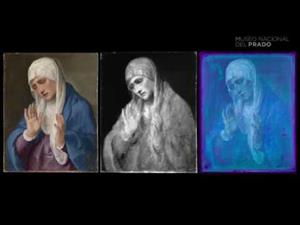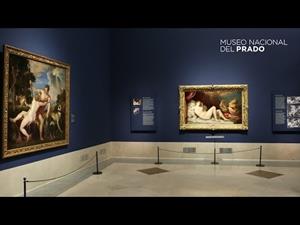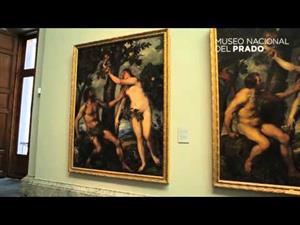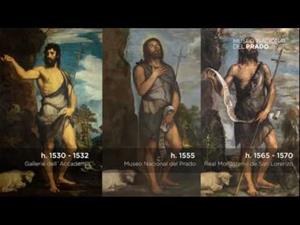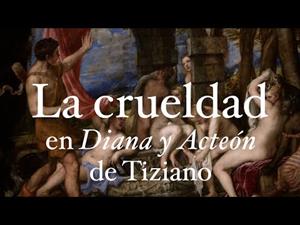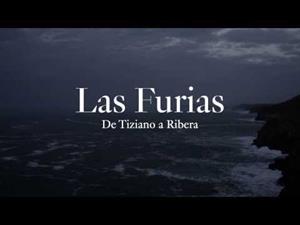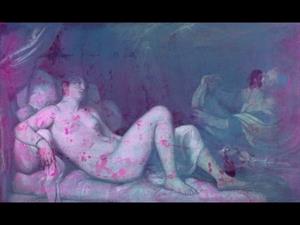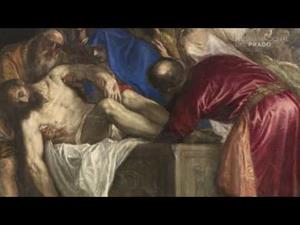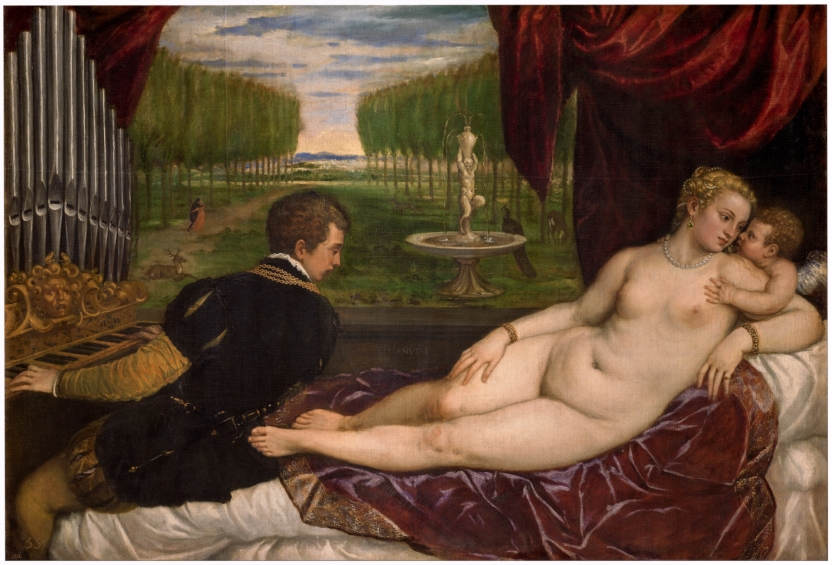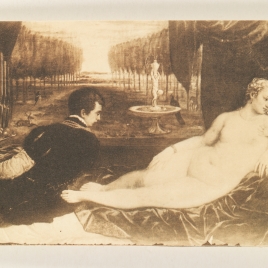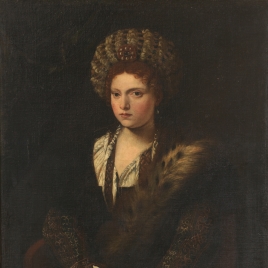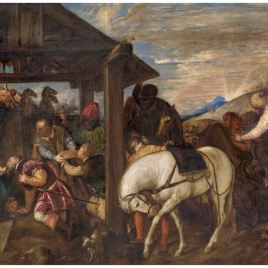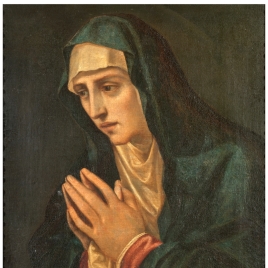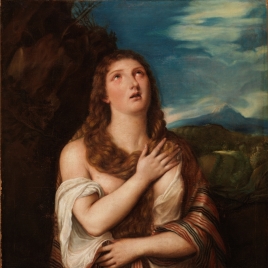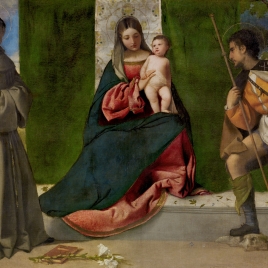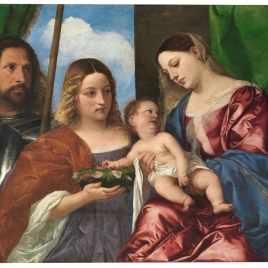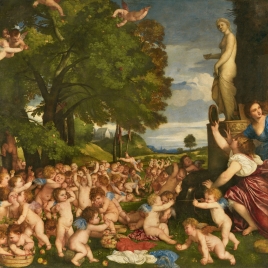Bibliography +
Casa Real del Pardo. 1614-1617, Inventarios Reales en 12 volúmenes y un índice, Madrid, 1617.
Inventario del Álcazar. 1666, Madrid, 1666.
Inventario Palacio Nuevo. 1747, Madrid, 1747.
Inventario Palacio Nuevo. 1772, Madrid, 1772.
Gronau, Già, Titian, London, New York, 1904, pp. 304.
Gronau, Georg, Titian, Duckworth and Co.Charles Scribners, Londres-Nueva York, 1911, pp. 304.
Beroqui, Pedro., Tiziano en el Museo del Prado., Boletin de la Sociedad Española de Excursiones, 33, 1925, pp. 85.
Suida, W, Tiziano, Roma, 1933, pp. 115-116.
Suida, W, Le Titien, Weber, Paris, 1935.
Tietze, H, Titian. Leben und werk, II, Wien, 1936, pp. 298.
Noul, M., Sotomayor, F., Muguruza, P., Les chefs-d'oeuvre du Musée du Prado, Musée d'Art et d'Histoire, Ginebra, 1939, pp. 35.
Brendel,O, The interpretation of the 'Holkham Venus', The Art Bulletin, XXVIII, 1946, pp. 65-75.
Beroqui, Pedro, Tiziano en el Museo del Prado, Hauser y Menet, Madrid, 1946, pp. 78.
Middeldorf, U, Letter to the editor, XXIX, 1947, pp. 65-67.
Berenson, Bernard, Italian pictures of the renaissance. List of the principal artists and their works with and index of places :Venetian school, I, Phaidon, London, 1957, pp. 187.
Studdert-Kennedy, W.G, Titian: The Fitzwilliam Venus, The Burlington magazine, C 667, 1958, pp. 348-351.
Valcanover, F, Tutta la pittura di Tiziano, II, Milán, 1960, pp. 35.
Panofsky, Erwin, Problems in Titian Mostly Iconographic, Phaidon, Londres, 1969, pp. 119-125 lám.136 122-123 nt.37.
Pallucchini, Rodolfo, Tiziano, I, G.C. Sansoni, Florencia, 1969, pp. p 35.lám.338,339.
Cagli, Corrado, La obra pictórica completa de Tiziano, Noguer, Barcelona. Madrid, 1971.
Lucie-Smith, Edward, Eroticism in Western Art, Thames and Hudson, Londres, 1972, pp. 172.
Sánchez Cantón, Francisco Javier, Museo del Prado. Catálogo de las pinturas, Museo del Prado, Madrid, 1972.
Ponz, Antonio., Viage de España, VI, Madrid, 1972, pp. 57.
Bermejo de la Rica, A., La Mitologia en el Museo del Prado, Editora Nacional, Madrid, 1974, pp. 26.
Inventarios reales: testamentaria del Rey Carlos II : 1701-1, Museo del PradoPatronato Nacional de Museos, Madrid, 1975, pp. 68,448.
Wethey, Harold E., The paintings of Titian, Phaidon, Londres, 1975, pp. 63-68,196-197 n.47.
Trevor-Roper, H., Princes and Artists. Patronage and Ideology at Four Habsburg, Thames and Hudson, Londres, 1976, pp. 53.
Pallucchini, Rodolfo, Profilo Di Tiziano, Aldo Martello, Florencia, 1977, pp. lám.34.
Rizzatti, Maria Luisa, Tiziano, Editorial Marin, Barcelona, 1977, pp. 97.
Museo Nacional del Prado, Museo del Prado: pintura italiana anterior a 1600, Gredos, Madrid, 1979, pp. 139-141.
Rosand, D, 'Ermeneutica amorosa:observations on the interpretation of Titian's Venuses' En: Tiziano e Venezia., Neri Pozza,, Vicenza, 1980, pp. 375-281.
Fasolo, Ugo, Ticiano, Becocci, Florencia, 1980, pp. 61.
Hope, Charles, Titian, Jupiter Book, London, 1980, pp. 156/ lám.82.
Bettini, S., Tiziano e Venezia, Neri Pozza, Vicenza, 1980, pp. lám.32.
Crawford Volk, Mary, Rubens in Madrid and the decoration of the King's summer Apartments, The Burlington magazine, CXXIII, 1981, pp. 513-529 fg.12.
Museo Nacional del Prado, Catálogo de las pinturas, Museo del Prado, Madrid, 1985, pp. 700.
Bosque, Andree De, Mithologie et Manierisme, Albin Michel, París, 1985, pp. 43.
Bock, H., The Gemaldegalerie, Berlin. A History of the Collection and, Weidenfeld and Nicolson, Londres, 1986, pp. 341.
Brown, Jonathan, Velázquez: pintor y cortesano, Alianza Editorial, Madrid, 1986, pp. 191/ lám.216.
Studdert-Kennedy,G, Titian. Metaphors of Love and renewal, Word and Image, III, 1987, pp. 32-36.
Junod, Philippe, La Musique Vue Par les Peintres, Vilo, Lausana, 1988, pp. 82.
Museo Nacional del Prado, Museo del Prado. Inventario general de pinturas (I) La Colección Real, Museo del Prado, Espasa Calpe, Madrid, 1990, pp. nº2355.
Giorgi, Roberta, Tiziano: Venere, Amore e il musicista in cinque dipinti, Gangemi, 1990.
Museo Nacional del Prado, Catálogo de los cuadros del Museo del Prado de Madrid, [s.n.], Paris, 1993.
Museo Nacional del Prado, Catálogo de los cuadros del Museo del Prado de Madrid, [s.n.], Paris, 1993, pp. 584.
Le siècle de Titien: l'âge d'or de la peinture à Venise, Reunion des Musées Nationaux, Paris, 1993, pp. 532 nº 176.
Herzner, V, 'Titians. Venus mit dem Orgelspieler' En: Begegnungen: Festschrift für Peter Anselm Riedl zum 60. Geb..., Werner,, 1993, pp. 80-103.
Buendía, José Rogelio, El Prado. Colecciones de Pintura, Lunwerg Editores, Barcelona, 1994, pp. 264.
Checa Cremades, Fernando, Tiziano y la monarquía hispánica: usos y funciones de la pintura veneciana en España (siglos XVI y XVII), Nerea, Madrid, 1994, pp. 96; 262, n. 32.
Bettagno, Alessandro, El Museo del Prado, Fonds Mercator Fundación Amigos del Museo del Prado, Madrid, 1996, pp. 197.
Benito Olmos, Aurora, Arte y música en el Museo del Prado, Fundación Argentaria Visor, Madrid, 1997, pp. 100.
Blazquez, Eduardo., El ideal de belleza femenina en el Renacimiento, Boletín del Museo e Instituto Camón Aznar, 1997, pp. 40/ lám.5.
Los Cinco Sentidos y el Arte, MUSEO DEL PRADO.GUIA PARA PROFESORE, Servicio de Educacion y Accion Cult, Madrid, 1997, pp. 70.
Goffen, Rona, Titian's Women, Yale University Press, New Haven; London, 1997, pp. 159-169 160 / lám. 91.
Cohen, Simona., Animals in the paintings of Titian. A key to hidden meanings, Gazette des Beaux-arts, 131/2, 1998, pp. 202/ lám.10.
Soto, Victoria., Descubrir jardines. Tópicos imagenes e imaginación para el estudio de la jardinería filipína., Reales Sitios, 1998, pp. 26.
Felipe II, Un monarca y su época. Las tierras y los hombres del Rey., Sociedad Estatal Commemoracion de Los Centenarios de Felipe II y Carlos V, Madrid, 1998-1999, pp. 349.
Portús Pérez, Javier, La Sala Reservada del Museo del Prado y el coleccionismo de pintura al desnudo en la corte española, 1554-1838, Museo del Prado, Madrid, 1998, pp. 293 nº 6.
López Torrijos, Rosa, Mitologia e Historia en las Obras Maestras del Prado, Scala Books, Londres, 1998, pp. 34.
El Jardín de Melibea, Sociedad Estatal para la Conmemoración de los Centenarios, Madrid, 2000.
Martín Moreno, Antonio., 'La música española en la época del emperador Carlos V' en La fiesta en la Europa de Carlos V, SOCIEDAD ESTATAL PARA LA COMMEMORAC, Madrid, 2000, pp. 221.
Venus. Bilder Einer Gottin, Alte Pinacothek, Munchen, 2001, pp. 130.
Arte y poesía: el amor y la guerra en el renacimiento, Sociedad Estatal de Conmemoraciones Culturales, Madrid, 2002.
In the light of Apollo: italian renaissance and Greece, Silvana, Athens, Milano, 2003, pp. 544.
Titian, Yale University Press, London, 2003, pp. 64/ lám.38.
Falomir Faus, Miguel, Tiziano, Museo Nacional del Prado, Madrid, 2003, pp. 248-251 nº 42.
Parret, Hermann, Venus Devoilee : la Venus D'Urbino du Titien, Editions Snoek, Bruselas, 2003.
López Fanjul, M. Pérez Preciado, J. J., Los números y marcas de colección en los cuadros del Museo del Prado, Boletín del Museo del Prado, XXIII, 2005, pp. 84-110.
Checa, Fernando, Tiziano, Venus y la música y la idea de la pintura, Quintana., 4, 2005, pp. 87.
De Tiziano a Goya. Obras maestras del Museo del Prado., Tokio - Osaka, 2006.
De Tiziano a Goya: grandes maestros del Museo del Prado, Museo Nacional del Prado: SEACEX, Madrid, 2007, pp. 235.
L' ultimo Tiziano e la sensualità della pittura, Marsilio,, Venecia, 2008, pp. 211.
Aikema,B, La casta Susana, Congreso Internacional Jacopo Tintoretto (Madrid 2007), 2009, pp. 45-47.
Le botteghe di Tiziano, Alinari 24 ORE, 2009, pp. 228-271.
Ausoni, Alberto, Music in art, J. Paul Getty Museum, 2009, pp. 39.
Álvarez Lopera, José, Sobre Tintoretto y el Greco, Congreso Internacional Jacopo Tintoretto (Madrid 2007), 2009, pp. 77-83.
Garrard, Mary D., Brunelleschi' s egg : nature, art, and gender in Renaissance..., University of California Press, 2010, pp. 193-236.
El Prado en el Hermitage, Museo Estatal del Hermitage: Museo del Prado, 2011, pp. 76-77.
Falomir, Miguel; Joannides, Paul, Dánae y Venus y Adonis: origen y evolución, Boletín del Museo del Prado, Número extraordinario, 2014, pp. 16-51 [17].
Martínez Leiva, Gloria; Rodríguez Rebollo, Ángel, El inventario del Alcázar de Madrid de 1666. Felipe IV y su colección artística, Consejo Superior de Investigaciones Científicas, Madrid, 2015, pp. 595 nº 935.
Arasse, Daniel, 'La Venus d' Urbin ou l'archétype d' un regard' En: Désir sacré et profane: le corps dans la peinture de la Renaissance, Editions du Regard, 2015, pp. 199-211 [200].
Portús Pérez, Javier, Displaying the Nude in Spain 1550-1834. The Sala Reservada, en: Splendor, Myth, and Vision: Nudes from the Prado, Clark Art Institute; Museo Nacional del Prado, 2016, pp. 50-66 [55, 60].
Portús Pérez, Javier, Displaying the Nude in Spain 1550-1834. The Sala Reservada, en: Splendor, Myth, and Vision: Nudes from the Prado, Clark Art Institute; Museo Nacional del Prado, 2016, pp. 50-66 [59].
Burke, Jill, The European Nude 1400-1650, en: Splendor, Myth, and Vision: Nudes from the Prado, Clark Art Institute ; Museo Nacional del Prado, 2016, pp. 16-49 [32].
Falomir, M, 'Titian. Venus with an organist and cupid" En:, Splendor, Myth, and Vision : Nudes from the Prado, Clark Art Institute ; Museo Nacional del Prado,, 2016, pp. 72--77 n.2.
Plebani, Paolo, 'Tiziano Vecellio. Venere e Cupido con suonatore di organo' En:, Peterzano: Allievo di Tiziano, maestro di Caravaggio, Skira ; Accademia Carrara, 2020, pp. 132-134, II.7.
Albl, Stefan, 'Titian and Venus' En:, Titian´s: Vision of Women. Beauty, Love, Poetry, Skira, 2021, pp. 281-301 [294 cat.nº 69].
Albl, Stefan, 'Tizian und Venus' En:, Tizians Frauenbild: schönheit, liebe, poesie, Kunst Historisches Museum, Viena, 2021, pp. 281-301 [295-5 cat. nº 69].
Albl, Stefan, 'Tiziano e Venere' En:, Tiziano e l' immagine della donna nel Cinquecento veneziano, Skira ; Kunst Historisches Museum,, 2022, pp. 287-307 [300 cat.nº 69].
Fiocco, G., Un Tiziano. La Venere Dalle Colombe, [s.n], Milán.


